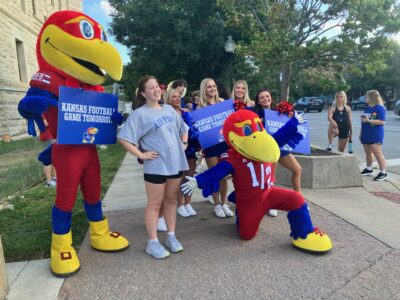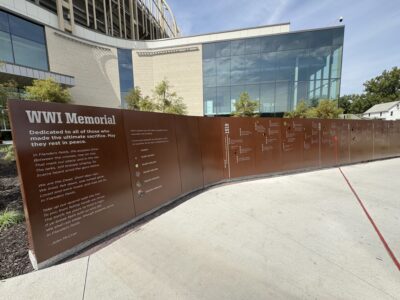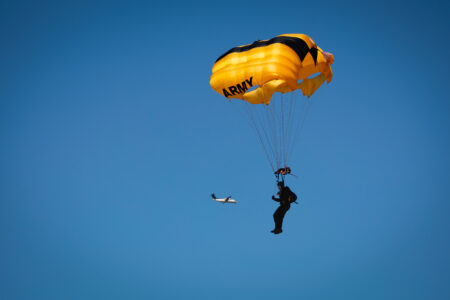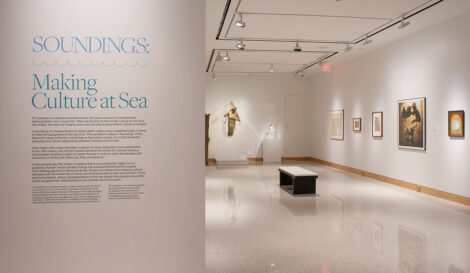KU students are working to restore Potter Lake’s native landscape during their ecology classes this fall
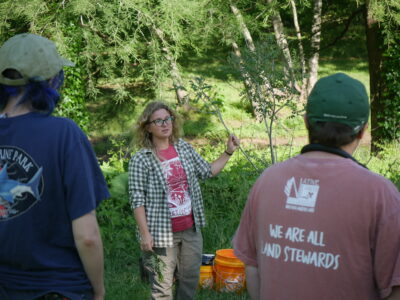
photo by: Shawn Valverde
Courtney Masterson, a KU lecturer in environmental studies and the executive director of Native Lands Restoration Collaboration, speaks to a group of students at Potter Lake on the University of Kansas Campus on Friday, May 30, 2025.
Courtney Masterson, a lecturer in environmental studies and the executive director of Native Lands Restoration Collaborative, worked with students on the banks of Potter Lake to plant native plants over the summer. That effort has now expanded to three other classes – including Megan Kaminski, Lisa Castle and Ali Brox, all lecturers in environmental studies at KU – who will be planting native plants below the slope of the dam between the lake and the stadium and restoring it to achieve a more native landscape.
There will be several sessions with all of the participating classes that will go out to the slope across two days to plant 1,000 native plants plus seeds.
“After everything is planted, then you just have to step back and let the plants do the work,” Masterson said. “Native seeds generally take two to three years to establish, to be mature, meaning that you’ll see a flower, so you’ll see them start to reproduce and spread. That’s why we’re adding the 1,000 native plants, because they’ll start blooming much faster.”
Masterson said the students will be working to create spaces with native species of plants to restore what was lost when the lake was first established in 1911. The lake was created to provide a reliable water source for fire protection.
She said the native plants of the region have supported the native animals and people of Lawrence for thousands of years.

photo by: Shawn Valverde
An aerial view of Potter Lake on the KU campus on Friday, May 30, 2025.
“By reestablishing them and involving students in that process, we help them to redevelop relationships, or for some of them, for many of them, for the first time (develop) relationships with the native plants and animals that have always called the land home,” Masterson said.
Masterson said the students will have the opportunity to plant the native plants onsite outside of the classroom and learn about how each of the species provide for the animals and humans that frequently use the space and what to expect aesthetically and ecologically over time.
She added that students will learn to choose plants that support the ecosystem and make smart business sense by requiring less water, fertilizer, and maintenance.
“It’s really special to work with the students because there’s an opportunity to engage young folk who may be entering careers that are affected by this work or will be informed by this work,” Masterson said.
Potter Lake has been undergoing a major restoration since last year, which involved dredging and other initiatives to improve the lake’s ecosystem and appearance. The project totaled $1.2 million and the goal is to restore the lake closer to its original depth of 18 feet and to rebuild a portion of the wall that runs along the edge of the water.
Jeff Pruess, a KU landscape architect, told the Journal-World that KU is in the process of cleaning up the water quality and restocking fish into the lake.
“And if we continue to have positive support and fundraising, then we’ll install maybe an aerator, more trees and other features out there, maybe an outdoor classroom as well,” he said.
Masterson said there is anticipated to be more opportunities for future students to plant native species at Potter Lake, and that there are several other locations where the addition of these plants would be beneficial to the area. In addition, the hope is that some of this restoration work will extend into Marvin Grove as well.
“With each phase being successful, we’ll move into the next phase (of restoration),” Pruess said. “So hopefully, we’ll have two or three more phases around Potter Lake and then we’ll move over to Marvin Grove to do a similar type of aesthetic changing … Using native plants and tree shrubs, it becomes more of an urban park for people to appreciate as opposed to a passive place where people kind of go through it.”


